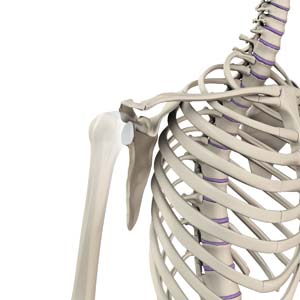
Anatomy of the Shoulder
The shoulder joint is a ball and socket joint. A ball at the top of the upper arm bone (humerus) fits neatly into a socket, called the glenoid, which is part of the shoulder blade (scapula). The glenoid is surrounded by a ring of fibrous cartilage called the labrum for stabilization of the shoulder joint.
What are Glenoid Fractures?
Fractures of the glenoid are rare but can occur due to major trauma or during high-energy sports activities.
What are the Symptoms of a Glenoid Fracture?
The symptoms of a glenoid fracture may include shoulder pain, swelling, a deformity at the site of the fracture and inability to move the arm.
Diagnosis of Glenoid Fractures
Your doctor will perform a thorough physical examination and order X-rays or a CT scan to determine the extent of the fracture and displacement of the joint.
Treatments for Glenoid Fractures
Non-displaced fractures require immobilization in a sling for about six weeks. If the fracture has led to the displacement of the bones, then surgery may be required to correct and fix them with pins, plates or screws. Physical therapy may be recommended to aid recovery, and improve range-of-motion and strength of the arm.
Other Shoulder Condition Topics:
- Acromioclavicular (AC) Joint Osteoarthritis
- Baseball and Shoulder Injuries
- Rotator Cuff Pain
- Massive Retracted Rotator Cuff Tear
- Bicep Tendon Rupture
- Proximal Biceps Tendon Rupture
- Long Head Biceps Tendon Rupture
- Proximal Biceps Tendinitis
- Shoulder Pain
- Internal Impingement of the Shoulder
- Sternoclavicular Joint (SC joint)
- SLAP Tears
- Arthritis of the Shoulder
- Shoulder Labral Tear
- Shoulder Labral Tear with Instability
- Shoulder Dislocation
- Shoulder Trauma
- Subluxation
- Little League Shoulder
- Frozen Shoulder
- Clavicle Fracture
- Glenoid Fractures
- Proximal Humerus Fractures
- Shoulder Disorders
- Hill-Sachs Lesion
- Thrower’s Shoulder
- Overhead Athlete’s Shoulder
- Snapping Scapula
- Shoulder Instability
- Shoulder Impingement
- Rotator Cuff Tear
- Acromioclavicular Joint Injury
- Shoulder Fracture
- Scapula Injury
- Biceps Tunnel Disease
- AC Joint Injury
- Revision RC Repair
- Revision Repair








